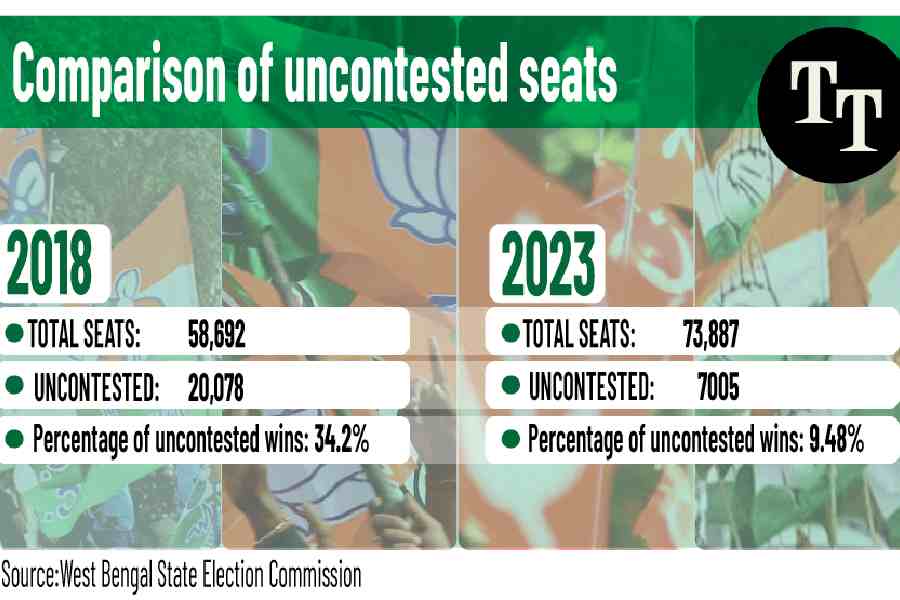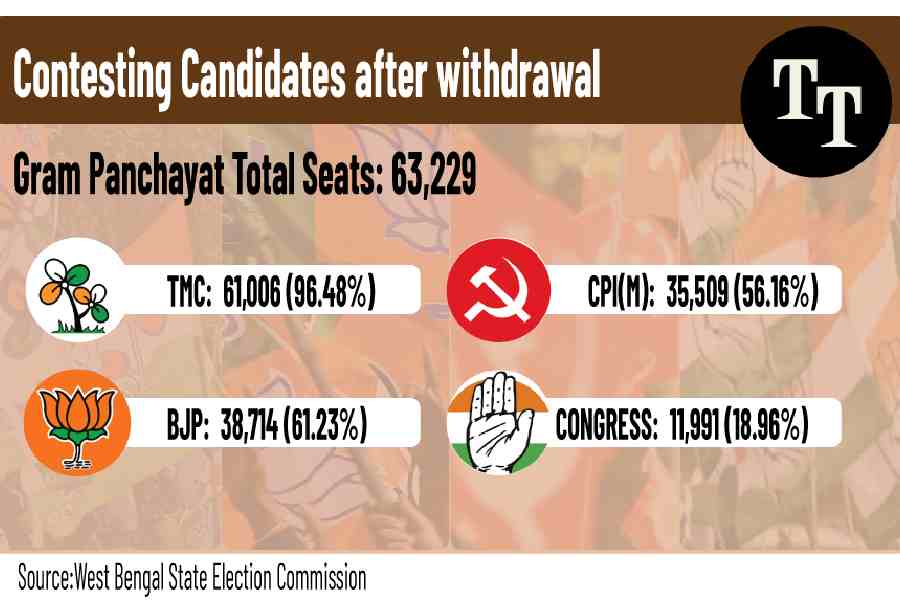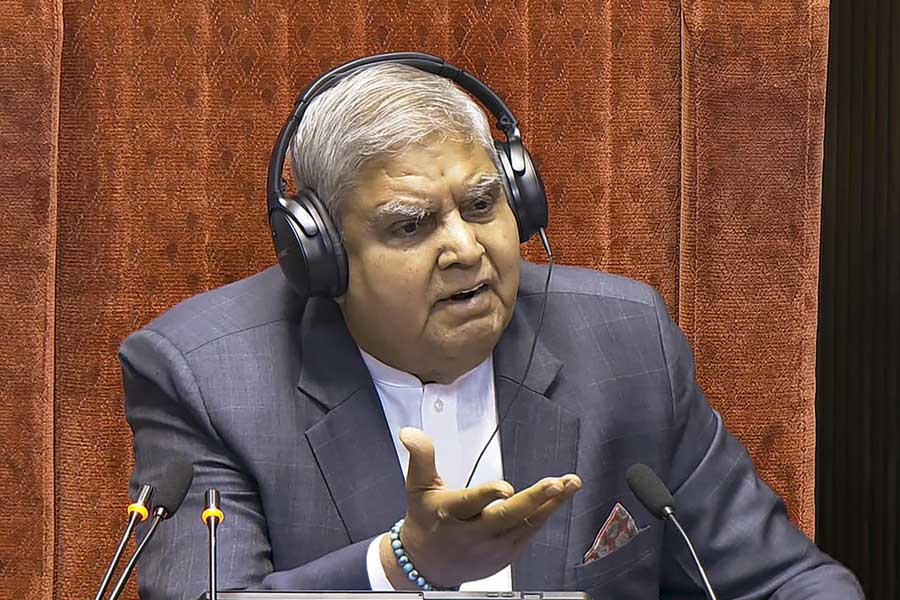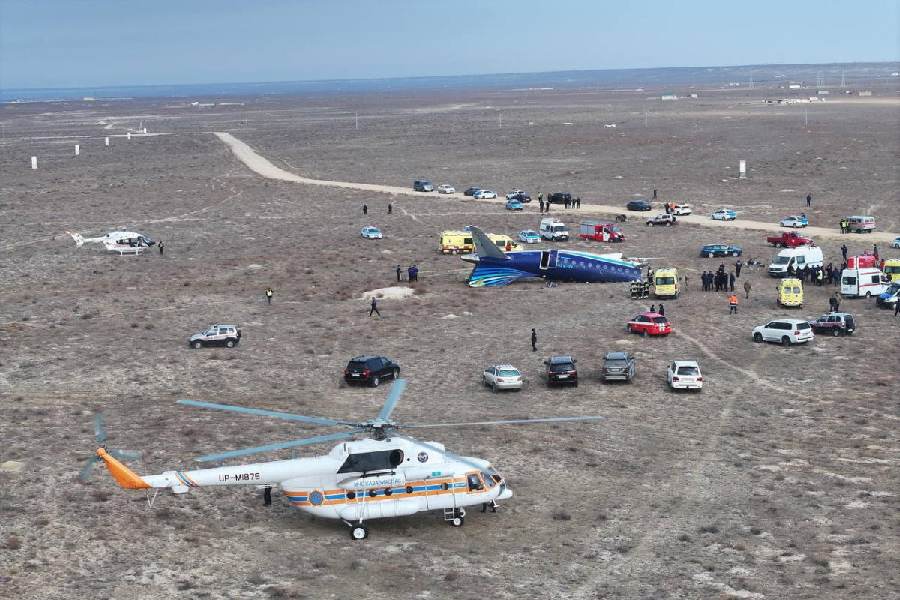Careful to not repeat panchayat poll mistakes of 2018 which perceptively cost the Trinamul Congress valuable vote share in the general elections which followed in 2019, the party’s uncontested wins in the current edition of rural polls have drastically come down to about 9 per cent seats across all three tiers of panchayats compared to the 34 per cent uncontested wins it registered in the previous edition.
Party insiders believe that allowing a closer fight with the Opposition at the countryside grassroots of Bengal would give the Trinamul a better chance in holding on to its rural vote bank for the crucial Lok Sabha elections scheduled to take place next year.
Figures from the West Bengal State Election Commission, past the scheduled deadline of withdrawal of nominations, confirm that candidates at 7,005 seats out of the 73,887 seats which are up for grabs across all three tiers won their seats uncontested. That’s about 9.48 per cent of the total number of seats. Considering that a few of these uncontested wins, albeit negligible in number, were also won by Opposition candidates, the percentage of Trinamul wins can be safely placed at close to nine.
Out of 63,229 Gram Panchayat seats, 6,238 candidates have won uncontested this time, commission figures stated. The corresponding figures for Panchayat Samiti and Zilla Parishad, as per the commission, were 759 out of 9,730 and eight out of 928 seats respectively.

Putting these figures in perspective and comparing them with the corresponding numbers of 2018 panchayat polls would clear the air on what Trinamul leader Abhishek Banerjee claimed he wanted to achieve in his two-month long Naba Jowar Yatra mass outreach campaign in the districts. In 2018, 20,076 out of the total 58,692 (34.2 percent) seats were won, overwhelmingly by the Trinamul, uncontested across all three tiers amid allegations of large scale violence, intimidation and political clashes which resulted in over 30 deaths during the entire poll process.
At the Gram Panchayat level, 16,814 out of the 48,650 seats were won by the ruling dispensation without having a single vote cast since there was no Opposition candidate to contest. At the Panchayat Samiti, the figure stood at 3,059 out of the 9,217 seats and at the highest Zilla Parishad tier the Trinamul won 203 out of the 825 seats without a contest.
What followed in the Lok Sabha elections in the following year in 2019 came as a nasty surprise to Trinamul supremo Mamata Banerjee. Making a quantum leap from its previous two seats from the state, the BJP won 18 of the 42 seats from the state. The party registered an unprecedented 40.6 per cent vote share, barely 3 per cent short of Trinamul’s 43.7 percent. The meteoric jump in BJP’s vote percentage stood at over 22 percent compared to its performance in the state in 2014.
Among other factors, the vote swing away from the Trinamul was attributed to the anger and despondency among the state’s electors who were denied the right to cast their votes in the rural polls the previous year. That’s the mistake which the party, evidently, wanted to avoid making this time around in the wake of the severe political polarization Bengal currently finds itself in ahead of the general elections next year.
But that may not be the entire story. The relative freehand which the Opposition received during this year’s polls, except of course for the intimidation tactic witnessed in the form of intense violence during filing of nominations in some pockets of the state which claimed five lives, may also have exposed the grassroots weakness of the Opposition.

Judging by the commission figures, the ruling Trinamul has fielded candidates in about 96.5 per cent Gram Panchayat seats. The corresponding figure for the state’s prime Opposition BJP stands at only 61.2 per cent. While the CPI-M has managed to file GP nominations in about 56 per cent seats, the Congress has fielded merely 19 per cent candidates at the lowest panchayat tier. The figures look a tad better for the Opposition in the Panchayat Samiti and Zilla Parishad levels but are still hardly anywhere close to the ruling dispensation.












